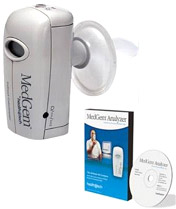Microlife MedGem Indirect Calorimeter Assessment And Treatment Part 2
 The MedGem indirect calorimeter is a clinically-validated and FDA 510K-cleared, class II, medical device for measurement of patient resting metabolic rate (RMR).
The MedGem indirect calorimeter is a clinically-validated and FDA 510K-cleared, class II, medical device for measurement of patient resting metabolic rate (RMR).
Instead of estimating RMR with the Harris-Benedict or Katch-McArdle formula, the MedGem scientifically measures a clients Metabolic Fingerprint, that is unique to them.
Estimation formulas cannot factor in thyroid issues, the effects of medications, etc.
Microlife MedGem WatchWT™ “Initiating the assessment & treatment for overweight and obesity”
WatchWT Scheduling/ Appointments
A. Front Desk
1. Front desk staff will schedule the patient for the MedGem diagnostic test during the time specified for this procedure. The office manager and nursing supervisor will determine the schedule.
2. If patient is calling to schedule a MedGem test, then front desk staff informs patient of pre-test requirements (see Section 3–Technician’s Measurement Script & MedGem Measurement Protocol Checklist).
3. MedGem appointments should be approximately 20-30 minutes (see Section 3–Optimizing MedGem Measurement Appointment Time).
4. A schedule is provided to the MA and updated regularly.
B. MedGem Appointment (approximately 20-30 minutes)
1. FRONT DESK: Receptionist provides patient with (see Section 6–MedGem Analyzer Patient Questionnaire) upon arrival.
2. PATIENT: Completes the MedGem Analyzer Patient Questionnaire in waiting room and returns questionnaire to the receptionist. Receptionist routes questionnaire to the MA per standard office procedure. The MA is notified by the computer check-in process.
3. MA or technician will conduct the measurement (see Section 3— MedGem Measurement Protocol Checklist).
Personnel will review the procedure with the patient and answer any questions (see Section 3— Technician’s Measurement Script).
Patient performs test in designated area.
Personnel records MedGem measurement on the MedGem Analyzer Patient Questionnaire.
Personnel informs patient to return for results and counseling session. Return visit options are given to patient according to clinic availability or capacity.
a. Shared medical (i.e. Group) visit (SMV—45 minutes). If patient chooses SMV, explain Confidentiality & HIPAA Notice (see Section 7—A Guide to Conducting a Shared Medical (i.e. Group)Visit)
b. Individual visit with health coach, care manager, PA/NP, or physician (15 minutes — 99213 if patient does not have an appropriate comorbidity for billing).
c. Chronic care visit for DM, Healthy Heart (30 minutes –99214).
4. FRONT DESK: Receptionist schedules patient for follow-up accordingly.
5. MA enters MedGem Analyzer Patient Questionnaire data into MedGem Analyzer software program (see Section 6– Generating Patient Profile with MedGem Analyzer Software).
MA prints the Your Personalized Weight Management Program report and gives to patient when they return for the SMV. MA prints the MedGem Analyzer Report (see Section 6 for reference) and files in the patient chart.
6. BILLING: Billing personnel use the appropriate diagnosis codes: PRIMARY (diabetes, hypertension, CAD, etc.) with SECONDARY diagnosis (overweight or obese).
E/M code 99211 with MedGem ICD-9 code 94690. Billing will also track payment and payer information on all submitted claims or provided spreadsheet.
The MedGem program includes the MedGem hand-held indirect calorimeter that measures resting oxygen consumption to determine resting metabolic rate (RMR); MedGem Analyzer software program to develop an individual treatment program; and Microlife’s educational materials for patient education. In addition, Dr. Hammond wanted to include MedGem into his established group visit program.
Offer your clients the best possible results by incorporating the MedGem tools and solutions into your programs.
For more information, click on MedGem indirect calorimeter.
Contact me at 1-800-743-3328 to discuss MedGem RMR System Kit pricing options.
Harvey Harris